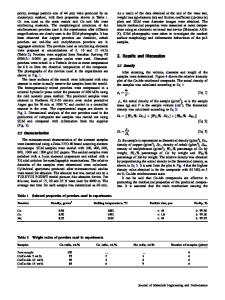Characterization and mechanical properties of ultrahigh boron steels produced by powder metallurgy
- PDF / 1,679,533 Bytes
- 7 Pages / 598 x 778 pts Page_size
- 49 Downloads / 318 Views
I.
INTRODUCTION
APPROPRIATE thermomechanical processes to achieve a fine microstructure in steels with high carbon content (1 to 2 pct C), usually referred to as ultrahigh carbon steels (UHCS), have led to the development of steels with improved mechanical properties at room temperature and superplastic behavior at high temperatures.t~,2,3] Optimal properties are obtained with a microstructure consisting of a fine dispersion of spheroidized carbide FesC particles of about 0.5/xm homogeneously distributed in a matrix of fine ferrite grains of about 1 /zm. The hard carbides provide good room temperature properties and maintain a stable fine grain during deformation at high temperatures. Similarly, equivalent amounts of boron added to steels should provide good room temperature properties and potential superplastic behavior at high temperatures if adequate processing is developed to achieve fine microstructures in these high boron steels, hereafter, referred to as ultrahigh boron steels (UHBS).t4-7]
Boron combines with iron to form stable borides which, if finely dispersed in the ferrite matrix, should act as the carbides in the UHCS. Solubility of boron in iron, however, is very low at any temperature (maximum solubility at 1000 ~ is about 33 ppm in "y-Fe).t8,9,1~ This indicates that all boron additions form boridest~t.~2.~3Jwhich do not dissolve in the matrix and should coarsen only at high temperatures. The low solubility of boron limits the possibility of warm formability of UHBS and the achievement of a fine microstructure by thermomechanical treatments as is the case for the UHCS. Rapid solidification and powder metallurgy techniques, however, reduce the formation of coarse second-phase ,par-
J.A. JIMI~NEZ, Postdoctoral Fellow, formerly with Centro Nacional de Investigaciones Metal6rgicas, C.S.I.C., is with the Max Planck Institut fiir Eisenforschung, 40237 D/isseldorf, Germany. G. GONZALEZ-DONCEL, Research Scientist, and O.A. RUANO, Professor of Research, are with the Centro Nacional de Investigaciones Metalflrgicas, C.S.I.C., Av. Gregorio del Amo 8, 28040 Madrid, Spain. Manuscript submitted December 8, 1994. METALLURGICAL AND MATERIALS TRANSACTIONS A
ticles providing a uniform distribution of dispersoids in the matrix, tjnJS] Therefore, these techniques should be applicable to the development of fine and homogeneous microstructures in UHBS free of large borides. It is well known that hard and large second-phase particles are sites of cavitation that promote brittleness and premature failure under tensile stresses. Furthermore, in order to preserve the fine microstructure, consolidation of the powders should be conducted at relatively low temperatures. This can be best obtained by hot isostatic pressing (HIP) t1637] or by extrusion at moderate or low temperatures. A very limited number of investigations exist on mechanical properties of iron-high boron alloys.t4-7] For this reason, an extensive research activity was conducted in our laboratory on the characterization and mechanical properties of two binary
Data Loading...











